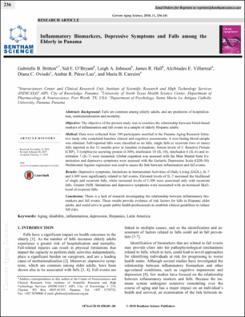Inflammatory Biomarkers, Depressive Symptoms and Falls Among the elderly in Panama
Fecha
2018-01-01Autor
Britton, Gabrielle
O'Bryant, Sid E.
Johnson, Leigh A.
Hall, James R.
Villarreal, Alcibiades E.
Oviedo, Diana C.
Pérez-Lao, Ambar R.
Carreira, María B.
Metadatos
Mostrar el registro completo del ítemResumen
Background: Falls are common among elderly adults, and are predictors of hospitalization, institutionalization and mortality. Objective: The objective of the present study was to examine the relationship between blood-based markers of inflammation and fall events in a sample of elderly Hispanic adults. Method: Data were collected from 190 participants enrolled in the Panama Aging Research Initiative study who completed baseline clinical and cognitive assessments. A non-fasting blood sample was obtained. Self-reported falls were classified as no falls, single falls or recurrent (two or more) falls reported in the 12 months prior to baseline evaluations. Serum levels of C Reactive Protein (CRP), T-lymphocyte secreting protein (I-309), interleukin 10 (IL-10), interleukin 6 (IL-6) and interleukin 7 (IL-7) were measured. Global cognition was assessed with the Mini Mental State Examination and depressive symptoms were assessed with the Geriatric Depression Scale (GDS-30). Multinomial logistic regression was used to assess the link between inflammation and fall events. Results: Depressive symptoms, limitations in Instrumental Activities of Daily Living (IADL), IL-7 and I-309 were significantly related to fall events. Elevated levels of IL-7 increased the likelihood of single and recurrent falls, while increased levels of I-309 were associated only with recurrent falls. Greater IADL limitations and depressive symptoms were associated with an increased likelihood of recurrent falls. Conclusion: There is a lack of research investigating the relationship between inflammatory biomarkers and fall events. These results provide evidence of risk factors for falls in Hispanic older adults, and could serve to guide public health professionals to establish clinical guidelines to reduce fall risks.

